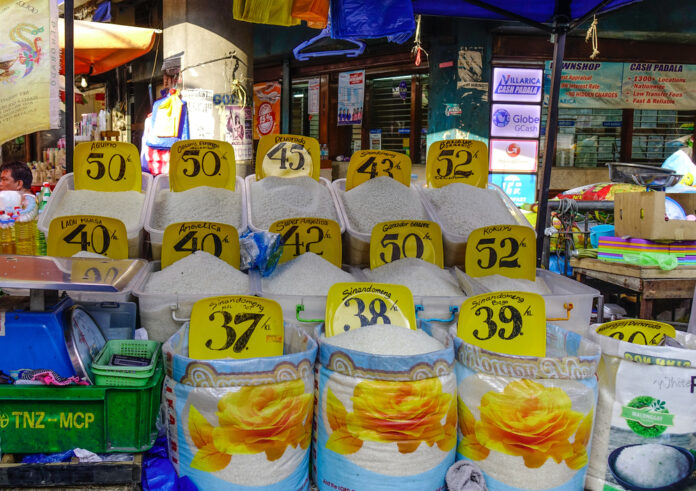Various groups on Sunday appealed for government to put in place a long-term solution instead of price ceilings on rice, saying such structures do more harm than good to consumers and farmers alike.
This has reference to Executive Order 39 issued Friday by President Ferdinand Marcos Jr. capping the price of regular-milled rice at P41 per kilo and well-milled rice at P45 per kilo starting Tuesday.
The price per kilo of imported rice ranges from P53 to P65 for the special variety; P53 to P56 for premium and; P43 to P52 for well milled, based on public market monitoring by the Department of Agriculture in the National Capital Region.
Data on the price of imported regular milled rice were not immediately available but for locally-grown special rice ranges from P54 to P65 per kilo; premium from P48 to P60 per kilo; well-milled from P47 to P57 per kilo; and regular milled from P42 to P55 per kilo.
According to DA monitoring, the price of some rice varieties is at least P15 per kilo higher that previous.
In January, the price of imported special rice ranged from P46 to P54 per kilo; premium rice from P43 to P48 per kilo; well-milled from P40 to P44 per kilo; and regular well-milled rice ranged from P37 to P38 per kilo.
Locally grown special rice variety ranged from P48 to P60 per kilo; premium rice ranged from P40 to P48 per kilo; well-milled ranged from P38 to P44 per kilo; and regular milled rice ranged from P35 to P40 per kilo.
The Foundation for Economic Freedom (FEF), a private think tank, proposed the government can instead do away or reduce import tariff on rice from 35 percent to 10 percent to help arrest rising prices rather than impose a price ceiling.
“The price cap will harm consumers because it will drive supply away from the market, fuel a black market for rice, cause traders to cheat consumers by mixing inferior broken rice with regular and well-milled rice and incentivize traders to hoard as the price ceiling is below their procurement and selling prices,” the think tank warned.
The group emphasized lower-income consumers in particular will suffer as regular milled rice becomes less available in markets at a controlled price and passed on as well-milled (and therefore expensive) rice by traders.
It said EO 39 will only harm farmers as traders merely use the price cap to justify lowering the purchase price of palay or simply refuse to buy them from farmers or lose money due to the high farm gate price.
“The price cap will harm the entire economy because it will not be effective in solving the demand-supply gap and arrest increasing food price inflation. It will only aggravate the current tight rice supply situation into a full-blown rice crisis. An Executive Order cannot repeal the law of supply and demand,” the FEF stressed.
It explained lifting the tariff or reducing the rice tariff to 10 percent will have an immediate effect on rice prices, adding the government can afford to lower the rate as the mandatory P10 billion allocation for the Rice Competitiveness Enhancement Fund as required by law has already been achieved.
The think tank cited a recent Bureau of Customs report showing tariff revenue from rice import totaling P16.8 billion as of August 23 this year.
It said the government may revert the tariff back to 35 percent when the situation stabilizes and the onset of the harvest season results in falling rice prices.
Data from the Philippine Statistics Authority, show the farm gate price of palay in June averaging P19.23 per kilo which is 9.4 percent higher than the year ago price of P17.58 per kilo.
Cathy Estavillo, Bantay Bigas spokesperson, had said palay farm gate price average P23 per kilo in Isabela province and P22 per kilo in Mindoro, which are rice producing regions.
But Estavillo expressed apprehension traders may later on buy palay at only P16 per kilo as weather-related disruptions occur.
Raul Montemayor, Federation of Free Farmers national manager, said the price caps under EO 39 “look unrealistically low.”
“If traders and millers cannot sell at that price, then either they stop selling rice or they shift to or rebrand their rice products to grades other than regular milled rice or well-milled rice in order to evade the price cap,” Montemayor said.
Rosario Guzman, IBON Foundation research head, said that without “meaningful production support and crackdown on traders’ price taking, the farmers will only bear EO with much lower farmgate price than what they are already receiving.”
Guzman said invoking the Price Act may be useful in emergency situations but argued the country’s rice problems are “long-drawn problems of neglect and trade liberalization” which was not addressed by EO 39.
The Samahang Industriya ng Agrikultura (SINAG), expressed support for EO 39 saying there is no reason for any price increase the past weeks given adequate grain supply in the country.
Jayson Cainglet, SINAG executive director, said traders have capitalized on the initial public panic created by the National Food Authority (NFA) claiming the buffer stock is only good for 1.5 days.
“Our stocks are good to last until the first quarter of next year and we have yet to harvest the expected 7 million metric tons (MT) of rice this harvest season. At any given time, our buffer stock is good for 50 to 60 days, prior to the onset of the harvest season later this month. Farm gate price remains at P24 to 25 per kilo and by harvest time by the end of this month, we expect a drop between P1 to P2 per kilo; there is really no basis for rice prices to increase,” Cainglet said.
SINAG also said rice imports as of August this year stood at 2.6 million MT, with more expected in December.
The organization urged the NFA to start buying palay from local farmers to beef up the buffer stock.







